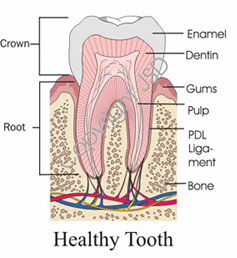What is an Endodontist and what do they do?
Endodontists are dentists who specialize in maintaining teeth through endodontic therapy -- procedures, involving the soft inner tissue of the teeth, called the pulp. The word "endodontic" comes from "endo" meaning inside and "odont" meaning tooth. Like many medical terms, it's Greek. All dentists are trained in diagnosis and endodontic therapy, however, some teeth can be especially difficult to diagnose and treat. That’s why you may have been referred to an endodontic specialist.
In addition to dental school, endodontists receive two or more years of advanced education in this kind of treatment. They study root canal techniques and procedures in greater depth, for diagnosis and treatment of more difficult cases. For this reason, many dentists choose to refer their patients to endodontists.

Diagnoses and Treats Pain
Oral pain such as toothaches or cracked / fractured teeth can often be difficult to pinpoint. Because of the vast network of nerves in the mouth, the pain of a damaged or diseased tooth often is felt in another tooth and/or in the head, neck, or ear. An endodontist is a specialist in diagnosing and treating this type of pain.
Treats Traumatic Injuries
Pulp damage is sometimes caused by a blow to the mouth, and the endodontist specializes in treating these traumatic injuries. For example, a blow to a child's permanent tooth that is not fully developed can cause the root to stop growing. A procedure called apexification stimulates bone to be deposited at the end of the root which makes it possible to then save the tooth through a root canal procedure. An endodontist is specially trained in procedures for replanting teeth that have been knocked out of their sockets.

What Happens During Endodontic Treatment? or What is a Root Canal?
A local anesthetic will be given. A sheet of latex called the "rubber dam" (we've got nonlatex ones too) will be placed around the tooth to isolate it, hence keeping it clean and dry during treatment. The treatment consists of three or four basic steps, but the number of visits will depend on your particular case. Some treatments take 2 visits but many are just a single visit. Occasionally 3 appointments are needed.
In any case, it depends on the degree of infection/inflammation and degree of treatment difficulty. To me, it's more important to do it the very best we can then to meet a specific time criteria. Let's look at the basic steps for nonsurgical endodontic therapy.
There are, of course, no guarantees. Root canal or endodontic therapy has a very high degree of success, up to 90%. Teeth which can be treated near ideal have a success rate up to ninety percent! We will discuss with you the chances of success before any endodontic procedure to help you make an informed decision. If a root canal or endodontic therapy is unsuccessful or fails you still have options.
Retreatment
Occasionally a tooth that has undergone endodontic, treatment fails to heal or pain continues despite therapy. Although rare, sometimes a tooth initially responds to root canal therapy but becomes painful or diseased months or years later. When either of these situations occur, the tooth often can be maintained with a second endodontic treatment.
What Is an Apicoectomy?
Generally, root canal treatment is all that is needed to repair your injured tooth. Occasionally, the root canal procedure will not be sufficient to completely eliminate the problem. If the tooth is not healing we may suggest surgical treatment. Endodontic surgery can be used to remove persistent infections, locate fractures, or treat hidden canals that do not appear on x-rays but cause pain in the tooth. Damaged root surfaces or the surrounding bone may also be treated with this procedure. The most common surgery used to save damaged teeth is an apicoectomy or root-end resection.
Endodontic Surgery known as Apicoectomy starts with an incision in the gum tissue to expose the damaged tooth and/or bone. The damaged portion of bone or root is removed and the surrounding areas are cleaned. Sometimes a root-end filling is placed at the end of the root to prevent re-infection. The gum is sutured back in place. The bone will heal naturally over the next few months. We will closely monitor you and your tooth during this time.
Following this procedure, you may expect some discomfort, swelling, and possibly bruising of the surrounding area. This is normal after any surgical treatment. We will guide you through the postoperative healing with specific instructions and medications as needed. We are only a phone call away if you have any questions after your surgery.
Will I need to return to your office for Additional Visits?
Once endodontic therapy is completed your tooth should be examined periodically, usually every 6 - 12 months. This allows us to make sure the tooth has healed or is healing properly. You will be asked to call our office 6 months after the procedure so that we can get you set up for a recall appoint, which is no cost to the patient. The doctor would like to take a CBCT to see how the surgery area is healing.

